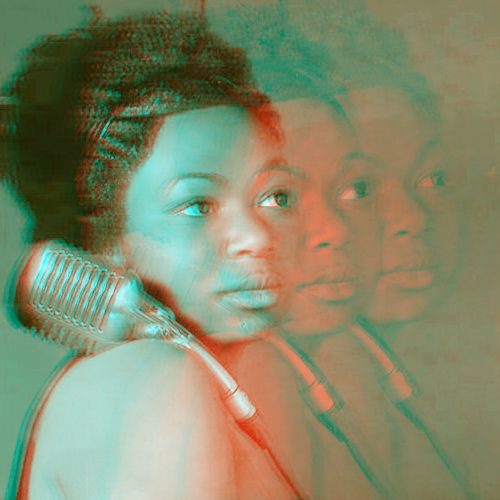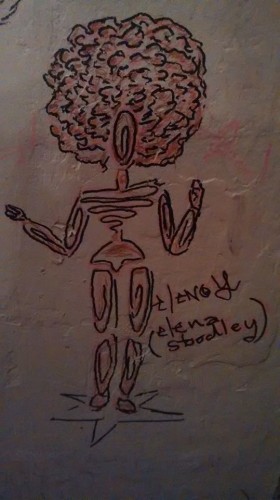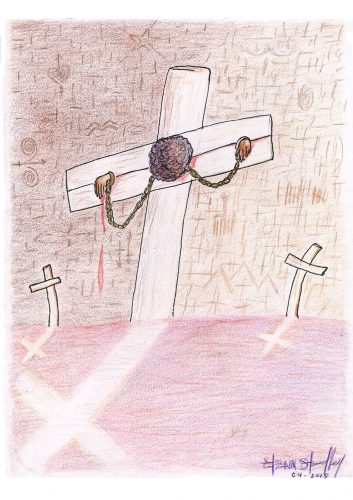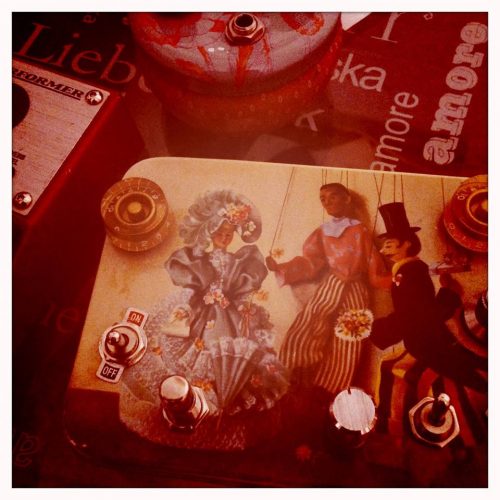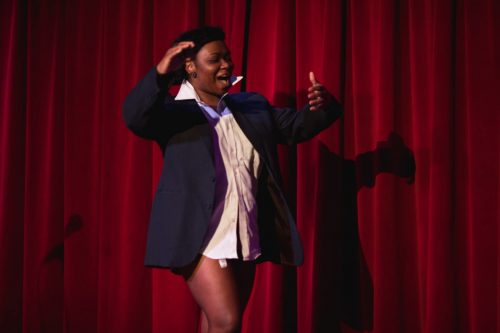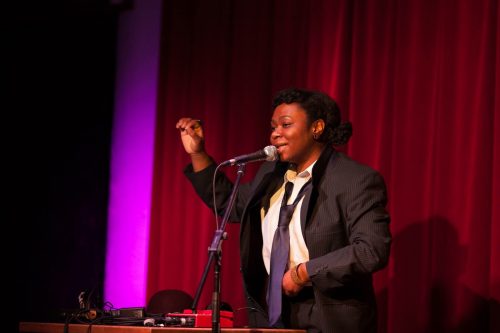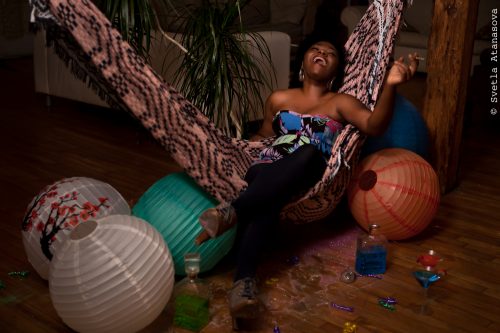Elena Stoodley is a Montreal-based, multidisciplinary artist most known for her sultry, jazz and rhythm and blues infused vocals and sound art performances. I met Elena when she was hired as the sound technician for the Create Dangerously: Congress of Black Writers and Artists that I was involved in organizing in the fall of 2013[i]. I have since come to know Elena and been increasingly interested in and inspired by the breadth of her art practices. The conversation between us written here represents a glimpse into our ongoing conversations about art and how the meaning of various art practices in our daily lives.
Elena, can you describe what “art” and “artist” mean to you and how you became aware of and developed a relationship to these words and meanings?
These are constant questions for me, a word that evolves in conjunction with my day-to-day life. So I see these questions as being connected, fully connected with any given moment, and the answers are determined by whatever feels right at that time.
I don’t feel very religious, in fact, when I was somewhere between 8 and 10 years old, I did a boycott and presented a sort of manifesto to my mom, so she would stop forcing me and my older sisters to go to church! I argued that religion is a personal choice, and that I have to choose mine through my own personal reflection on my spirituality… I was that kind of kid. Anyways, I’m not religious but I am spiritual, and I see myself as part of a whole, a force. When I make art I am engaging that spiritual wholeness; I am working in sync with that force or sometimes disrupting it to bring it into another direction that makes sense to me.
It took me a long time to understand I was an artist and what type of artist I would be. I was born into a Haitian immigrant family, and my parents’ family grew up in the violent dictatorship of the Duvaliers. This resulted in a constant silencing of opinions, since expressing political opinions could cost a life and or loved one’s life in that time. Because I was very vocal about my views, and often the youngest in a setting, it became a mission within my immediate and extended family to control me. Every adult would give a try at lecturing Elena! The saying, “it takes a village to raise a child” was really the deal in my childhood.
Singing became my time to be alone and allow myself to do anything—my protective bubble. And in classes at school, I would draw to fight stress and stay focussed. I used to fight a lot with other kids at school and was often punished, which resulted in having to see a social worker during class time when I was 11 years old. The social worker taught me to put words on my impulsive emotions, and write them instead of hitting someone, so I always had pen and paper on me, and this is how I started to write poems. I grew up listening to my parents music, chanson française, Haitian music, traditional voodoo music, Michael Jackson, my older sister’s music, rap (such as Wu-Tang, Biggie Smalls, Lost Boys, KRS-One), neo-soul or RnB– D’Angelo was one of my favourites. The way rap artists of the 1980s and ‘90s played with words has always been associated with images of my childhood, and a moment that was ours, as young black people. It was an era where my white friends had no idea of what I was listening to and that made me feel special, this was OUR music. My music now naturally reflects these moments that defined me. And because of that introduction to writing as a form of therapy, I developed a pattern of dealing with situations by writing about them in songs.
Performing is the continuation of an art piece. The way I give it life in front people, while feeling in sync with the “force,” I see it as giving another life to my creation, its second stage. And when I am fully in sync during a performance, it feels like meditation, almost a spiritual ritual and it sure gives me a high.
An artist is a person who is okay with that: getting into the zone and owning it entirely and sharing that moment with other people who want to live it with you. I am that.
Being an artist also means being a builder. I’m working slowly towards creating a world that makes sense to me because I don’t see it existing already, so every artistic expression, is a brick for my chateau.
I really appreciate the language you’re using, of art practice bringing you into sync with a bigger whole, ‘into the zone,’ and how this is in part a spiritual practice. It reminds me of the notion of ‘the flow’ that people sometimes achieve through art making, like a trance state that we achieve through emerging ourselves entirely in a challenge that’s motivated by more than our own self-interest[ii]. Being in a state of flow is definitely an ecstatic experience—the ‘high’ you refer to. For me that feeling is more than being inspired, it’s like being one with inspiration. Does this jive with what you’re describing?
I like this way of representing inspiration. My personal definition developed itself through time. For me inspiration is being able to listen to society. Being inspired is knowing how to put myself at the collision of ideas and creating a new idea out of that.
This can only be achieved by being in the moment, entirely. Kind of meditating but instead of clearing out my mind of random thoughts, I focus on listening.
What about your drawings? Do you still make visual art as well?
I stopped drawing years ago, when my drawings were exhibited in a small community event, and I was never able to retrieve them. When I tried to get them back I was told that they had probably been thrown in the garbage. That was around 13 years ago, and after that I went from drawing constantly to barely ever drawing. In the past 3 years I have been drawing more often again though, with a few bursts of drawing activity here and there.
That’s awful that someone was so careless with your artwork, I’m sorry that happened!
To draw or sing are simply examples—everyone has to find the most comfortable way to express themselves artistically. What is most important to me are the unique ways an artist puts ideas together to create a new idea. More important than the message is how an artist mobilizes who they are, their perceptions and the skills they have in expressing that message.
With musician friends we created a collective that focuses on Haitian diaspora expression while still reflecting our individual artistic approaches. I proposed an idea for a song to them which suggests that we should put ourselves at afro-ease everywhere we go, to express the idea that we are at home, everywhere, especially in the Western world.
An example: I recently went to a Boukman Experyans show at the FrancoFolies festival[iii]. This is a traditional Haitian music band with a strong voodoo expression. When we think of voodoo music, we think drums, but a sound problem made certain drums inaudible which really affected the vibe of the performance. The personal touch was taken away. As soon as the show ended, a group of Haitian fans in the crowd who had brought their own percussion erupted into a spontaneous session of traditional rhythms that kept the audience dancing freely for an hour after the band’s last note was played. Se défouler was what the crowd had expected in the show! This was art—it was being in the moment and creating what was supposed to happen at the time. The Haitians are free!
Do you see a difference in the function/s of different art forms? What if anything is the distinction between your performance art and visual art?
I see all art forms as very connected to each other. The creation process I often use involves mixing ideas and creating sense out of the chaos. In writing or drawing, the birth of something new is almost always generated by a collision between concepts.
I also have some key ideas that are a foundation in my visual art and emerge in most of my drawings. Same in my writing and even in my sound art.
Can you explain what sound art is?
Sound art is similar to visual art, but the expression is used less frequently in the mainstream art world. Basically, any production of sound, organically or digitally for example, can become my instrument, my medium to create an art piece. For me, some work—especially politically oriented work—only makes sense as sound art.
For example, I created a multichannel piece (sound comes out of 8 speakers placed in a circular set up) where I express the diaspora reality of not knowing what to call home. During my last trip to Haiti, I recorded a number of outdoor scenes and included them in this piece; they represent Chez Moi, my home. I also have recorded presentations at several conferences I have gone to about Black people’s realities. They represent Chez Nous, an informal way to refer to home in Quebec, but also used as a Québecois nationalist assertion—our home. Using variations in volume I create a back and forth between these two worlds, centered by my voice reciting a poem I wrote. The poem includes my personal diasporic story, within Haiti’s story. I recorded myself reciting the poem using contact microphones on my skin, so the words can be heard as if they were an internal voice.
Sound art for me is all about feeling a certain flow of things. I like to think that I just adjust my sound art pieces to my internal beat box, my blood pumping, which changes depending of my mood. So if I feel like I can breathe naturally to an art piece while composing, it works for me.
If I had to make a distinction between my different art practices I’d say drawing allows me to create a single representation of a combination of ideas, whereas a song allows me to share a short time with the audience and/or another musician, where I develop an idea for a few minutes and allow them to interpret it whichever way they want. They can bring that moment wherever they go and play with it if they sing it on their own time. Sound art is creating an atmosphere, a soundscape, a canvas where the listener can also find space for their own ideas.
Writing a book, which I’m also doing now, is allowing me to explore more ideas and bring them into new people’s lives, allowing readers to live with them while imagining them in their own ways.
I should add that it’s a bit weird that I have explained all of the above with so much emphasis on the sharing and interpretation of my art, because really, when I compose I don’t think about the listener otherwise I would censor myself. I usually think about the reception when I feel my art is ready to be shared. And not all my art reaches that status.
Can you comment on practices of collecting, collage, assemblage, and display? This is a big focus for me as an artist who engages primarily in assemblage practices. I have always “curated” spaces with which I have a connection in particular ways that involve assemblage and display, and I have noticed that you do the same in your home. What do you make of all this?
Just the other day I was talking to another artist and I free styled this theory of how everything that is in my house is a direct expression of me and a picture of where I am mentally at the moment. Every time I change the place of something, it is a consequence of how I feel and also has an effect on how I feel. The same way Facebook is a tool to visually organize social relationships and networks, decoration, the accumulation of objects, and the order of things in my house is a visual representation of the diverse aspects of my personality.
At home, I have a lot from Ikea (which to me reflects laziness in terms of originality), combined with art from people I know and my own art, pretty much everywhere. I also have so many second hand objects lying around, and a lot of Haitian presence. When I collect a new item, usually either it goes along with what I already have and I was expecting it before I even discovered it existed or, I take it because it triggers a strong reaction in me of misunderstanding it and I wonder what my life will turn into with its presence in it.
In teaching art to youth I have enjoyed exploring what they imagine it to mean to “think like an artist”. What does this mean to you? What might it mean to “act like an artist” based on this “kind of thinking”?
I really don’t like the expression “act like an artist”. I see “artist” as an identity, a way of being and interacting with the world. If someone needs to “act like an artist,” they are not one. I didn’t choose to be an artist, expressing myself is survival for me. I couldn’t fake being an artist, I might not be inspired for a period of time, but I would still be an artist. This is how I see the world.
I think I understand what you’re saying, I do think that some people seem to “naturally” be artists in how we approach life and how important art making is to our well being. I guess I’m thinking as an art educator also, about how much of that is learned—the difference between nature and nurture. For example how you learned how to put words and music to your emotions, and what explains how many artists have parents who were involved in the arts. For me, creating art is about imagining different ways of being and experimenting with different visual perspectives. I’ve thought about the invitation to ‘think like an artist’ as a way of inviting young people to practice using their imaginations and suspend the rules about what they believe is and isn’t possible. I guess to rephrase my question, what parts of being an artist (if any) do you think are learned and what aspects are more a matter of personality?
One thing resonates first with me is that the expression “creating art” is strange to me, even though I can’t necessarily find a more appropriate one. It sounds like an euphemism to me. Art is creating. Maybe we could say, a translation and synthesis of ideas into a single entity? Maybe enabling art to happen or facilitating art?
I guess what can be taught is how to be in tune with art or how to listen to our internal discourse that is processing the outside world we constantly interact with. React to it, through art. Teaching art, in my eyes is giving tools to artists to discover themselves, to understand and master their most comfortable ways of expressing themselves.
Endnotes
[i] For more information about the Congress see here: http://c-uni-t.org/2013/11/30/sommaire-de-levenement-event-summary/
[ii] Csikszentmihalyi, M., Abuuhamdeh, S. & J. Nakamura (2005). Flow. In A.J. Elliot & C.S. Dweck (Eds.). Handbook of Competence and Motivation, Chapter 32 (pp. 598-608). New York: The Guilford Press.
[iii] An annual francophone music festival held in downtown Montreal.
